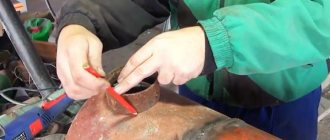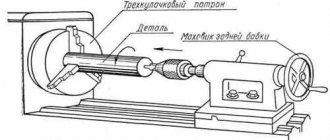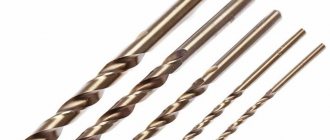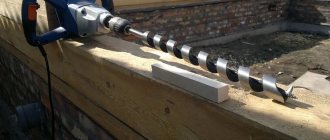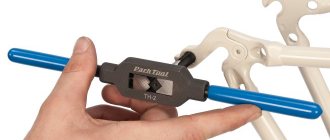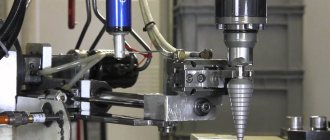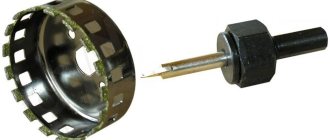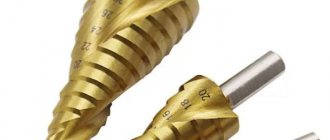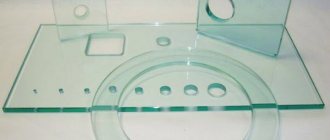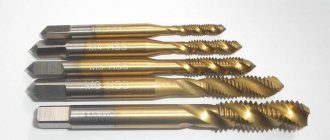Drilling large holes is not a problem if you choose the right tool. For example, such work may be necessary to secure a channel or metal corner. The easiest way is to use an electric drill, but getting a hole with a diameter of, for example, 15 mm requires a lot of effort. To drill a large diameter hole in metal, special devices and core drilling technology are used.
Drill accessories
There are several accessories for drills that can make the process easier and make a large hole smooth:
- Drilling jig. This device is a housing in which there are several guide bushings for drills of different diameters. The material used to create the bushings is harder than drill bits, so you don't have to worry about the tool moving to the side while drilling and widening the hole.
- Drill guide. This product allows you to fix the tool in such a way that it does not deviate to the side during drilling. If such a product is not available, the tool may move to the side, resulting in an uneven edge. It can also be mounted at an angle. But when drilling metal products, this is usually not required.
- Drill stand. A DIY product like this can be an inexpensive replacement for a drilling machine, as it allows you to carry out work more comfortably. When using a stand, a fixed tool moves along the bar using a lever. In this case, displacement is completely eliminated, since the workpiece being drilled is securely held due to the presence of a clamp.
Using these products, you can greatly facilitate the process of drilling metal products.
Coordinate punching of metal
This method of obtaining holes implies that the holes will be obtained in a certain sequence. This operation can be used in the manufacture of both simple parts and rather complex metal structures. Such processing of sheet metal requires high precision from the equipment and control program, since errors in the settings and program code can lead to substandard products.
Coordinate punching of metal
Metal punching as a technological operation has existed for quite a long time, but in recent years, thanks to the advent of systems with numerical software, it has changed significantly. Thus, modern equipment makes it possible to perform operations on punching holes with an accuracy of their placement up to 0.05 mm. Coordinate punching equipment allows processing steel of different grades with a thickness from 0.5 to 8 - 10 mm. Coordinate punching of a metal sheet is used in the production of housing parts, fastening kits, etc. To obtain a set of holes, a series of punch blows is used on the sheet. The breakdown order is entered into the control computer program. By the way, the use of computer programs and appropriate tools for punching holes in metal guarantees the quality of the finished products.
The use of coordinate punching presses for punching holes in metal provides a manifold increase in production speed and therefore it is used for large-scale and mass production of parts from sheet metal.
Feature of deep holes
To drill a deep hole in metal, it is best to use a lathe. Cooling must be done during this process. In this case, the chips must be forcibly removed. Periodically, the tool is removed from the workpiece to remove chips.
When working without specialized devices, you should not recess the nozzle more than 2/3 of its length. Water must be used for cooling during operation. If the work is done in several approaches, changing the angle is not allowed.
Drill a hole in metal
Drilling through holes in metal workpieces is done with various tools using special techniques. Many specialists, when performing engineering work, have to drill holes in metal structures quite often. These objects have high elasticity, which forces the use of special cutting devices when drilling.
Types of drills and devices for drilling in metal
The necessary equipment for drilling metal products are electric and hand drills, as well as drilling machines. The working part of such devices is a drill of different shapes:
- spiral;
- screw;
- crown-shaped;
- conical;
- flat;
- cannon;
- rifle;
- centering;
- stepped.
Each drill is individually marked, where the tip indicates the cross-sectional diameter and the type of alloy from which it is made. To drill a hole of the required diameter, you need a drill a few tenths of a millimeter narrower.
Drills are also classified by length:
- short;
- elongated;
- long.
Drilling in some materials may require a specially sharpened diamond-tipped drill bit. Twist drills may not be able to handle products made from thin sheet alloys.
In some cases, to drill deep holes, the product must be fixed in a vice, stops, jigs, or corners with fasteners.
This is done for safety reasons and to obtain high quality holes.
Modes for drilling holes in metal products
For drilling through holes in metal products, preliminary preparation for the process is extremely important. The drill must be correctly secured and guided in the tool.
You need to adjust the rotation speed and other parameters. For products that are too strong, a low drill speed is recommended.
An indicator of correct drilling should be uniform, long chips.
Types of holes and methods for drilling them
Some manufacturing jobs often require the following types of holes in metal workpieces:
- Through. They completely pierce metal workpieces. It is important to protect the surface of the machine from accidental exit of the drill beyond the product to avoid damage to the drill and the occurrence of burrs on the blank. Workbenches with holes, where it is possible to place a wooden spacer under the workpiece, are ideal for such types of work. Holes in thin blanks are drilled with flat drills, because a twist drill can noticeably destroy the edges of the product.
- Deaf. They are carried out to the required depth without penetrating the product right through. In this case, an important point is measuring the depth, which can be conveniently done by limiting the length of the drill by the stop of the sleeve or the drill chuck with a locking stop. Professional machines are equipped with automatic feeding systems for a given depth of penetration, which allows you to fix the depth of the drill.
- Deep. This type of hole includes those drills whose length is five times the diameter. When drilling deep holes, it is necessary to periodically remove the resulting chips using additional lubricants. Often it is necessary to enforce measures to cool the drill and the workpiece itself, the temperature of which rapidly rises to too high levels as a result of friction. This applies to workpieces made of high-strength alloys. For deep holes, twist drills are used.
- Wide diameter. Drilling large-diameter holes in products of large proportions is a very responsible and labor-intensive process. For such holes, conical, crown-shaped or stepped drills are used. Specialists carry out drilling at low tool speeds, trying to ensure the safety of the edges of the workpiece.
- Complex shape. Sometimes it is necessary to drill through or blind holes in workpieces of different densities for internal threads. The technology has to be divided into two actions: preliminary preparation of the site and the drilling itself.
- Half-hearted. Half blanks are drilled, filling the cavities with wood. Stepped holes can be obtained using one of two techniques: reaming (passing a drill of a smaller diameter to the entire depth of the workpiece, followed by drilling with drills of a larger diameter) and reducing the diameter (drilling a hole of a larger diameter to the required depth, followed by replacing a drill with a smaller diameter). As a result, the hole is clearly centered.
Safety when drilling holes in metal workpieces
When drilling holes in metal workpieces, you should be very careful to avoid rapid destruction of the drill. Following simple rules when drilling will ensure safety and guarantee a high-quality product upon completion of the work:
- On the eve of drilling, you must carefully check the fixation of all fastening devices on the machine.
- You can start work in special clothing to prevent any elements from getting under the moving parts of the machine. Protect your eyes from metal shavings with special glasses.
- When the drill tip enters a metal workpiece, it should already be rotating at low speeds to avoid dulling.
- The drill should be pulled out of the drilled hole gradually, reducing the speed, but not stopping completely.
- When the drill tip does not penetrate into the workpiece, you will have to check the strength of the metal. When running a file over the surface, it is possible to determine the degree of strength. If there is no roughness left on the alloy, you need to choose a drill with a diamond tip or from a harder material, and drill at low speeds.
- Drills of small diameter, which are difficult to fix in the chuck, are recommended to be wrapped with brass wire on the tail to increase the diameter of the girth.
- If you are working with a polished workpiece, you can put a felt washer on the base of the drill to avoid damage when it comes into contact with the drill chuck.
- To fix metal workpieces made of polished or chrome-plated steel, fabric or leather spacers are used.
- When drilling deep holes, a small piece of compressed foam placed on the drill will ensure that small metal shavings are blown away. Also, foam plastic will make it possible to deepen the drill to the required level when producing blind holes.
The power of electric drills must be taken into account when drilling holes in metal workpieces of varying hardness. Manufacturers of electric tools mark devices by indicating technical characteristics on their housing. For drills of different power, drills of the appropriate diameter are required.
https://www.youtube.com/watch?v=ZjueKzIhTVs
You can entrust any metalworking work, including drilling, to the specialists of the Proflazermet company. We ourselves will determine the required hole diameter and select the appropriate tool, of which we have a large selection. As a result, you will get the perfect solution in a short time.
| [td]» Articles » Professionally about metalworking » Drilling machines |
We recommend purchasing:
Installations for automatic welding of longitudinal seams of shells - in stock!
High performance, convenience, ease of operation and reliability in operation.
Welding screens and protective curtains are in stock!
Radiation protection when welding and cutting. Big choice. Delivery throughout Russia!
Depending on the required quality and number of workpieces to be processed, holes are drilled using markings or a jig. During the work process, the following basic rules must be observed:
- when drilling through holes in workpieces, it is necessary to pay attention to the method of securing them; if the workpiece is mounted on a table, then you need to place it on a support to ensure free exit for the drill after processing is completed;
- the drill should be brought to the workpiece only after turning on the spindle rotation so that when it touches the surface of the workpiece, the load on it is small, otherwise the cutting edges of the drill may be damaged;
- Do not stop spindle rotation while the drill is in the hole being machined. First you need to remove the drill, and then stop rotating the spindle or stop the machine, otherwise the drill may be damaged;
- if a grinding noise or vibrations occur during drilling resulting from jamming, misalignment or wear of the drill, you should immediately remove it from the workpiece and then stop the machine;
- When drilling deep holes (l>5d, where l is the depth of the hole, mm; d is the diameter of the hole, mm), it is necessary to periodically remove the drill from the hole being machined to remove chips, as well as to lubricate the drill. This significantly reduces the likelihood of drill breakage and premature dulling;
- a hole with a diameter of more than 25 mm in solid metal is recommended to be drilled in two transitions (with reaming or countersinking);
- drilling should be performed only according to the modes specified in the technological maps or in the tables of reference books, as well as according to the recommendations of the foreman (technologist);
- When drilling holes in workpieces made of steel or viscous materials, it is imperative to use coolant to protect the cutting tool from premature wear and increased cutting conditions.
Drilling by marking is used in single and small-scale production, when the manufacture of jigs is not economically justified due to the small number of processed parts. In this case, the driller receives marked blanks with control circles marked on them and the center of the future hole (Fig. 6.21, a). In some cases, the marking is made by a driller.
Drilling according to the markings is carried out in two stages: first, preliminary drilling, and then final. Pre-drilling is carried out with manual feed, drilling a small hole (0.25d). After this, the spindle and drill are retracted, the chips are removed, and the alignment of the circle of the overdrilled hole with the marking circle is checked.
If the preliminary hole is drilled correctly (Fig. 6.21, b), drilling should be continued and completed, and if the hole has gone to the side (Fig. 6.
21, c), then make the appropriate adjustment: cut two or three grooves 2 with a narrow chisel (crossmeisel) on the side of the center where you want to move the drill (Fig. 6.21, d).
The grooves guide the drill to the location designated by the center punch. After correcting the offset, continue drilling to the end.
Drilling on the jig
To guide the cutting tool and fix the workpiece according to the requirements of the technological process, various jigs are used.
Constant mounting bases of the device and jig bushings that provide direction to the drill increase the accuracy of processing.
When drilling along a jig, the driller performs several simple techniques (installs the jig, the workpiece and removes them, turns the spindle feed on and off).
Drilling through and blind holes. There are mainly two types of holes in workpieces: through holes, passing through the entire thickness of the part, and blind holes, drilled only to a certain depth.
The process of drilling through holes is different from the process of drilling blind holes. When drilling through holes, when the drill comes out of the hole, the resistance of the workpiece material decreases abruptly. If you do not reduce the feed speed of the drill at this time, it may become jammed and break.
This happens especially often when drilling holes in thin workpieces, through intermittent holes and holes located at right angles to one another. Therefore, drilling a through hole is carried out with a high mechanical feed speed of the spindle.
At the end of drilling, you need to turn off the feed speed and drill the hole manually at a speed lower than mechanical.
When drilling with manual tool feed, the feed speed before the drill leaves the hole should also be reduced somewhat, drilling should be done smoothly.
There are three main methods of drilling blind holes.
If the machine on which a blind hole is drilled has any device for automatically turning off the spindle feed speed when the drill reaches a given depth (reading rulers, dials, hard stops, automatic stops, etc.), then when setting up to perform this operation it is necessary to adjust to the specified drilling depth.
If the machine does not have such devices, then to determine the achieved drilling depth, you can use a special chuck (Fig. 6.22, a) with an adjustable stop.
The thrust sleeve 2 of the chuck can be moved and installed relative to the body 1 with the drill at a given processing depth.
The machine spindle moves down until the end of the bushing 2 stops at the end of the jig bushing 3 (when drilling along the jig) or into the surface of the workpiece. This chuck ensures hole depth accuracy within 0.1...0.5 mm.
If greater accuracy of drilling depth is not required and there is no specified chuck, then you can use a stop in the form of a sleeve attached to the drill (Fig. 6.22, b), or mark the depth of the hole on the drill with chalk. In the latter case, the spindle is fed until the drill goes deep into the workpiece to the mark.
The drilling depth of a blind hole is periodically checked with a depth gauge, but this method requires additional time, since you have to remove the drill from the hole, remove the chips and, after measuring, reinsert it into the hole.
Features of large diameter holes
This procedure is more complex than deep drilling. Cutting work is carried out either using a crown or using a cone drill. Crowns for metal are similar to products for concrete and drywall. The only difference is the material used to create the cutting edge.
Drilling can also be carried out with standard products in several stages. To do this, first use a nozzle of small diameter. Then a larger tool is selected.
The most convenient way is to use cone drills. Such devices allow you to drill a large hole in one go. To do this, the tool is simply recessed into the material.
Calculation of the required punching force
The metal cutting process is characterized by the fact that during this process a rather complex load pattern appears, which is concentrated in the area where the punch, the material being cut and the matrix interact.
The punch is made in such a way that it does not enter the material with its entire end, but only with the outer annular part. The response comes from the matrix. Moreover, the pressure arising in the interaction zone of these three components is distributed unevenly.
In other words, during the cutting process a pair of forces arises that form a circular bending moment. Under its influence, the sheet bends. As a result of this bending, pressure is generated, which affects the punch and the edge of the matrix. In addition, it is necessary to take into account the fact that tangential forces appear under the influence of friction forces. As can be seen from the above, when punching, a non-uniform force field arises. Therefore, when carrying out calculations, a conventional value is used - shear resistance. As a result of the research, the resistance depends not only on the properties of the metal, but also on the level of hardening, the thickness of the cutting, the gaps in the punch/die pair and the speed of the cutting process.
Hassle-free drilling
During work, you can use a small section nozzle, as well as a used grinding wheel for an angle grinder. It is important to remember that it should have a smaller diameter than the hole being created.
Before carrying out work, a circle for the hole is marked on the workpiece, and the second circle will be smaller than the first by a distance equal to the diameter of the drill used. After this, 2 holes are marked in opposite places of the circle. It is necessary to retreat 3 mm from them and mark the places for drilling. Thus, drilling occurs along the entire drawn circle. If additional work is necessary, some areas will have to be processed with a chisel. This will create jagged edges that will then need to be filed down. It is important to ensure that during work the circumference does not increase, i.e. do not expand the planned diameter.
Cone drill
The described types of drills are made from tool steel. The shanks of such products can be hexagonal or cylindrical. The cutting edge removes all burrs, so the edge is smooth. The end of the drill head has a sharpened point that allows pre-drilling of the material.
Using these products you can:
- create cuts with a diameter of up to 30 mm;
- forget about jagged edges;
- carry out boring of various diameters without changing the nozzle.
Thanks to step drills, you can create cuts of various diameters in sheet steel up to 4 mm thick. Unlike a simple cone drill, when using such products, the drilled diameter is fixed.
The disadvantages include:
- the need to use tools with low speeds and high torque;
- sensitivity even to small distortions.
Despite these disadvantages, this attachment allows you to conveniently work with metal plates, quickly drilling circles of the required diameter.
Metal crown
Metal processing is a complex process, so such work is usually carried out using specialized equipment. To carry out work at home, you can use core drills.
Such products allow you to make the edges round and centered. In this case, a standard drill is used for drilling. The products consist of several parts:
- crown;
- centering attachment;
- product shank;
- screws that are necessary for fastening.
When using a core drill, the speed of work increases up to 10 times. Another advantage is the ability to accurately drill in the range from 1.2 to 15 cm.
In this case, there is no need to perform alignment during drilling. It is also worth noting that such drills have higher wear resistance compared to twist drills.
Before starting work, a centering drill is installed in the center of the circle, after which drilling is carried out. After this, the drill is retracted and the work is carried out with a crown.
Drill types
For drilling, use only metal drills (not wood, for example). They have their own sharpening and are made from certain types of steel. The most common ones are marked P6M5 - this is high-speed steel, which foreign manufacturers label as HSS.
To provide additional strength, the above drill bits are coated with titanium nitride. That's why they are yellow.
There are also stronger P18, which are used respectively for hard steels.
Also, to increase strength, cobalt can be added, and then the marking P6M5K5 is obtained.
Well, the most durable ones are drills with carbide tips. They are used for drilling alloy steels. It will also take ordinary steel, but buying it just for this will be somewhat savvy, since the price for them is quite high, and although it is hard, it still dulls. But it will be difficult to sharpen it later, since this requires a diamond blade, which is also not very cheap, and you can’t buy it everywhere.
How to drill metal
.
Drilling metal with a drill is somewhat more difficult than wood, brick or concrete. There are also some peculiarities.
For convenience, we have combined practical advice on this type of work into step-by-step instructions.
- You will need the following tools: drill, drill, coolant (preferably machine oil, but water can also be used), punch, hammer, safety glasses.
- When drilling metal on a horizontal surface, place a wooden block under the product and fix it as best as possible. When working in a vertical position, rigid fixation is extremely important, since drilling must be strictly perpendicular.
- We make markings, then use a center punch and a hammer to mark the center of the future hole.
- Pour coolant into a small container.
- We put on safety glasses.
- Let's start drilling. Do not put strong pressure on the drill, because it works better at low speeds. If the drill is powerful, then the method of short-term activation is suitable until the tool has time to reach maximum speed.
- Don't forget to cool the drill as often as possible.
- When drilling occurs not strictly perpendicularly, but at an angle, there is a high probability that the drill will jam. If this happens, put the switch in the reverse position. This way you will avoid injury and will not break the drill.
- If you did everything correctly, then even at home, using a low-power drill, you can drill a hole in metal up to 5 mm thick inclusive and with a diameter of up to 10-12 mm. We will talk about more complex tasks below.
Metal drilling work
Is it possible to drill into metal with a concrete drill?
It is possible, but this is in case of extreme necessity for shallow holes with a small diameter. Unprofitable.
It is better to use either standard metal drills with steel grade R6M5 or improved ones - R6M5K5.
The letter K in the marking indicates that this is an alloy with the addition of cobalt. On the market you can find a drill called “Cobalt”. We will not vouch for all manufacturers; we will only note that reviews of practical use in the vast majority of cases are positive.
How to drill with a step drill in metal?
Step drills are universal - just one can make holes of different diameters (from 2 to 40 mm). They are most effective when working with thin metal, when you need to get a neat edge.
They are better fixed in the cartridge, they are easier to sharpen, and therefore, with proper use, they last longer, but they also cost more than usual.
The principles of working with them are the same, but it is easier to drill large-diameter holes than with conventional twist drills.
Is it possible to drill metal with a Pobedit drill?
The principle of operation of drills for metal is to cut, and with pobedite soldering, crush materials. Brick, concrete, and stone are better suited for this. Therefore, as mentioned above, you can, of course, drill metal with a drill for concrete, but it will quickly become unusable and the victorious soldering will be destroyed.
Revolutions
What is the larger hole diameter? the lower the speed should be. The greater the depth? Therefore, you gradually need to reduce the pressure on the drill. With a drill diameter of up to 5 mm, the torque should not be higher than 1200-1500 rpm. Accordingly, 10 mm in diameter - no more than 700 rpm, 15 mm - 400 rpm.
How to drill holes in large diameter metal?
As a rule, most drills for household use have a power from 500 to 800 W, which allows you to drill holes with a diameter of up to 10-12 mm.
How to properly drill metal thicker than 10 mm with an electric drill?
In metal up to 2 mm thick, using step drills you can make holes up to 40 mm. With a thickness of 3 mm, bimetallic crowns are better suited.
Bimetallic crowns have proven themselves when working with stainless and carbon steel and non-ferrous metals. They also work well with multilayer materials such as wood, chipboard, plywood, plastic, plexiglass, slate.
Bimetallic crown
When drilling deep holes with any tool, you may sometimes need a magnet to remove the chips.
Metal drilling process
Particular attention should be paid to safety precautions, be sure to protect your eyes from chips, and if there is distortion and jamming, immediately turn off the drill and change the torque to reverse movement.
In conditions where there is no electricity or when the noise of a working tool can disturb others ( read : when can you make repairs so as not to quarrel with your neighbors?) - the ideal solution for drilling metal would be a hand-held mechanical drill, the so-called brace. Low speed and pressure, no overheating, just what you need. Of course, there are also disadvantages - time-consuming and easy fatigue. In this simple “old-fashioned” way, you can drill holes with a diameter of up to 10 mm.
We hope our tips will be useful to you.
More information in this video.
.
.
- Mecutoil lubricating and cooling fluid Manufacturer: Karnasch (Germany) Professional coolant for drilling and cutting metal.
How to drill metal with a drill - detailed step-by-step instructions
Concentrate for dilution with water. 5% emulsion - for normal steel and non-ferrous metals, 10% emulsion - for stainless and high-alloy steel, in difficult conditions can be used in a 50/50 ratio, as well as undiluted. Read more >>>
- Cutting fluid IVKAT Manufacturer: Vector (Russia) Coolant Ivkat TU 0258-141-05744685-95 is a semi-synthetic water-soluble cutting fluid for metalworking operations. Used to reduce temperature, processing power parameters and wear of cutting tools, dies and rolls. Blade and abrasive processing of cast iron, steel, aluminum and copper alloys. Read more >>>
- Spray for drilling Fein Manufacturer: Fein (Germany) Highly effective aerosol Fein for lubrication and cooling of cutting tools. Spray can 300 ml. RUR 1,623 Read more >>>
- Fein paste for drilling and cutting metal Manufacturer: Fein (Germany) Paste in a 300 ml aerosol can, used for cutting and sawing sheet metal. RUR 1,357 Read more >>>
- Lubricating and cooling aerosol Mecutspray Manufacturer: Karnasch (Germany) Coolant - Mecutspray aerosol. Does not contain freon, biodegradable composition - an environmentally friendly product for lubrication and cooling when drilling and cutting ferrous and non-ferrous metals. Read more >>>
- Lubricating and cooling soft lubricant Manufacturer: Karnasch (Germany) Universal paste for metalworking. Ideal for use in overhead drilling of non-ferrous metals and all grades of steel. Does not contain chlorine compounds. Read more >>>
- Lubricating and cooling wax Manufacturer: Karnasch (Germany) Special wax for non-ferrous metals. Ideal in conditions where splashing is not acceptable or when working overhead. Read more >>>
- Coolant pump Manufacturer: Karnasch (Germany) Coolant supply container More details >>>
The drilling procedure can easily be called one of the most important metal processing technologies.
Subscribe to site news
The main purpose of drilling is to produce mounting and technical holes of various diameters, depths and shapes, thread cutting, counterbore and countersinking. This procedure is carried out on drilling machines of various sizes and configurations. Also engaged in the production of stuffing boxes.
Using the drilling method, carried out on modern equipment, and the use of special tools, various operations are performed, among which the following can be distinguished:
· Drilling cylindrical holes;
· Drilling holes with an oval or multifaceted configuration;
· Drilling, countersinking and even grinding existing holes.
Drilling technology involves the possibility of producing both blind and through holes in metal structures of various sizes and shapes. At the same time, using special equipment equipped with CNC, it is possible to ensure high accuracy of holes and prepare a product, for example a sliding support, for subsequent assembly or further operations prescribed in the technological process.
This method is used for processing products or workpieces made from various types of steel and cast iron. Naturally, for each material, a cutting tool (drill, countersink, reamer), as well as processing modes, lubrication and other parameters are individually selected.
This type of metalworking, such as drilling, is indispensable in various fields of industry, ranging from small enterprises engaged in small-scale production of components for equipment, and in large factories that have a full production cycle for a certain range of products. The processing accuracy, as well as the characteristics of the holes produced by drilling, directly depend on the machines, tools and technologies used.
